When it comes to foraging for wild mushrooms, the honey mushroom has long been a sought-after delicacy. Renowned for its rich flavor and meaty texture, this edible fungus can be found in forests across North America.
However, the hunt for honey mushrooms is not without its challenges. One of the most significant obstacles faced by mushroom enthusiasts is distinguishing these delectable fungi from their look-alikes.
Many species bear a striking resemblance to honey mushrooms, both in appearance and habitat preferences, making identification a tricky task even for experienced mycologists.
List of Honey Mushroom Look Alikes
1. Deadly Galerina Mushroom
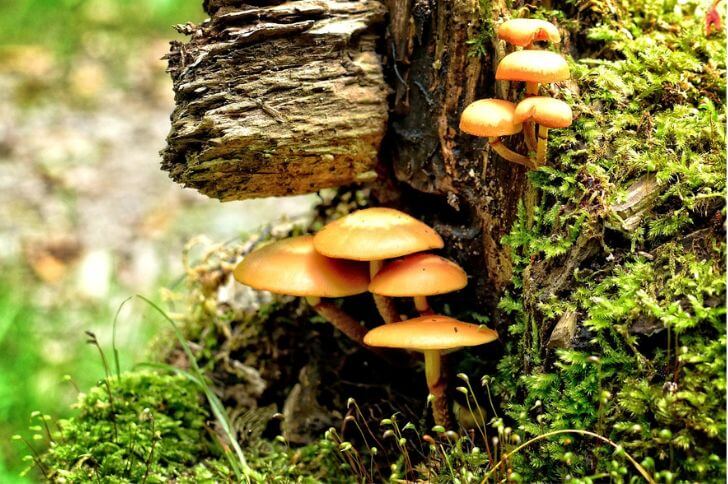
One of the most dangerous look-alikes to the honey mushroom is the deadly galerina mushroom (Galerina marginata). This species closely resembles the edible honey mushroom in appearance, making it difficult for inexperienced foragers to distinguish between the two.
The deadly galerina can be found growing on decaying wood, just like its edible counterpart, further complicating identification..
The key factor that sets apart the deadly galerina from the edible honey mushroom is its toxicity. This species contains a potent toxin called amatoxins. Amatoxins are not destroyed by cooking or drying and are known to be highly resistant to digestive enzymes in our body.
To avoid confusion and ensure your safety when foraging for mushrooms, it is crucial to educate yourself thoroughly about their distinguishing features before setting out on any wild mushroom hunt.
The main distinguishing feature between these two species lies in their habitat preferences. Deadly galerinas tend to grow on decaying wood or tree stumps, whereas honey mushrooms prefer living trees as hosts.
This divergence in habitat could be attributed to the distinct ecological roles these fungi play in nature – while honey mushrooms act as primary decomposers of infected or weakened trees, deadly galerinas thrive on decaying organic matter.
2. Sheathed Woodtuft (Kuehneromyces mutabilis)
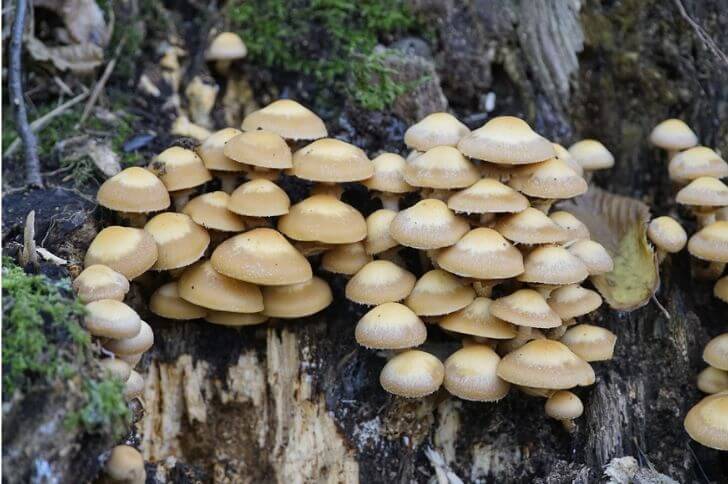
Another common look-alikes of the honey mushroom is the sheathed woodtuft. This edible fungus is often mistaken for the honey mushroom due to its similar appearance and growth habits.
The sheathed woodruff, scientific name kuehneromyces mutabilis, has a cap that ranges in color from light brown to reddish-brown and can grow up to 3.1 inches in diameter.
The gills are initially pale turning cinnamon as the mushroom matures. And, like the honey mushroom this mushroom also grows on stumps of alders and birch.
While sheathed woodtuft is generally considered edible and has a mild flavor, it is essential to exercise caution since it can be confused for the galerina above.
3. Flammulina Velutipes (Velvet Shank)
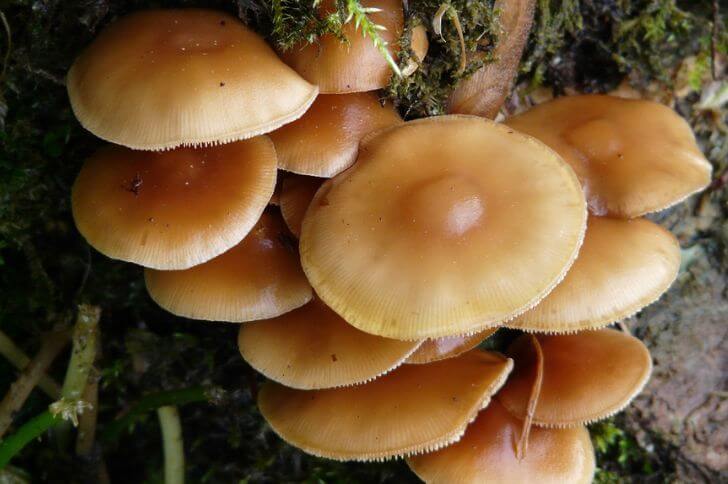
Another type of mushroom that resembles honey mushroom is flammulina velutipes, also known as the velvet shank. This mushroom species closely resembles honey mushrooms in appearance and growth habit, making it challenging for inexperienced foragers to distinguish between the two.
The cap of velvet shank is convex or flat with a smooth surface and typically has a brownish color. Its gills are close together and white when young, turning yellow as they mature. Another striking similarity to honey mushrooms is that both species have a stem that has a velvety texture.
Despite their similarities, there are some key differences that can help differentiate flammulina velutipes from honey mushrooms. One noticeable distinction is in their habitat preference – while honey mushrooms are commonly found growing on decaying wood, velvet shanks prefer living trees, particularly those infected with diseases such as root rot or canker diseases.
Additionally, these honey mushroom look alikes tends to have a more elongated stem compared to honey mushrooms which usually have short stubby stems.
4. Hypholoma Capnoides
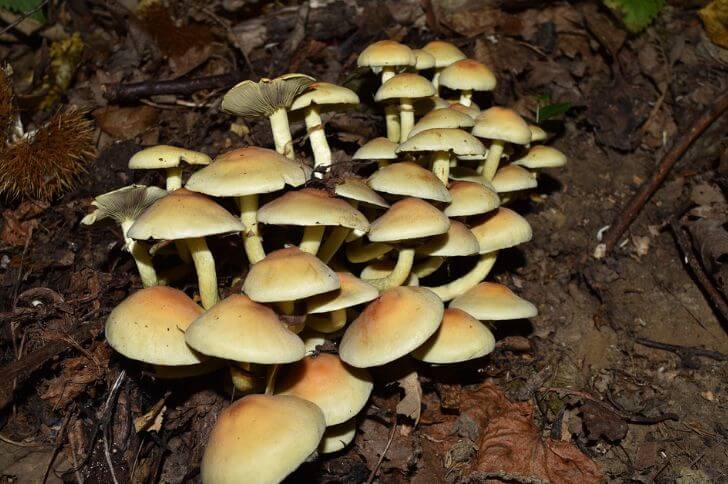
Hypholoma capnoides is another species of mushroom that resembles the honey mushroom and is often mistaken for it. And, like honeys, this mushroom is also considered suitable for consumption.
This fungus typically grows in clusters on decaying conifers or old tree stumps, similar to Armillaria mellea. It has a distinct orange-brown cap with a slightly sticky texture when moist. The gills underneath are crowded and initially pale gray but darken with age.
Its stem is smooth and usually colored with shades of yellow or brown, sometimes exhibiting a slight curve towards the base.
5. Hypholoma Lateritium (Brick Cap)
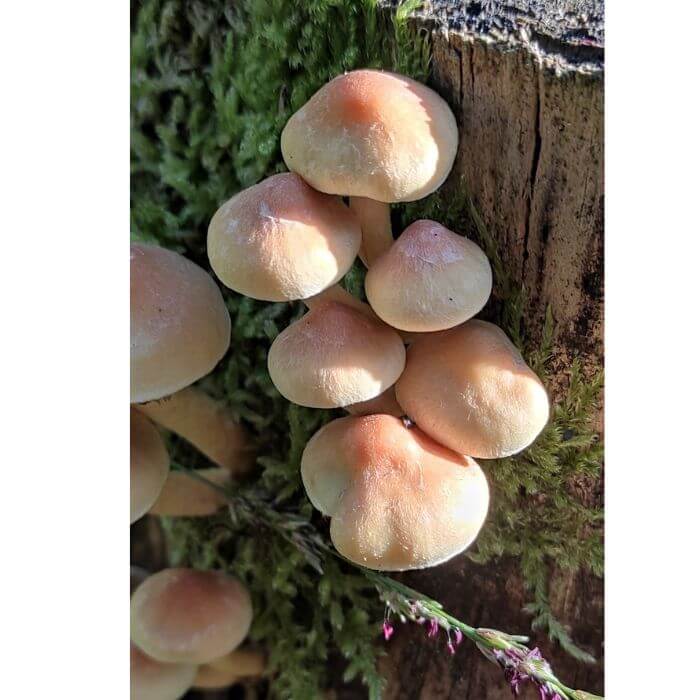
One of the most well-known and frequently encountered look-alikes to the honey mushroom is Hypholoma lateritium, commonly known as the brick cap. This species shares a similar habitat preference with honey mushrooms and often grows in clusters on decaying wood or stumps.
The brick caps have a distinct orange-brown cap that ranges from 1.3 – 3.9 inches in diameter and features a slightly convex shape.
One key characteristic that distinguishes brick caps from true honey mushrooms is their gills. While honey mushrooms have white or cream-colored gills, brick caps have yellowish gills that turn gray with age. Additionally, the spore print of this honey mushroom lookalike is purple-brown, unlike the white spore print of true honey mushrooms.
Brick caps are edible. They have a nutty flavor that most mushroomers enjoy.
6. Golden Scalycap (Pholiota aurivella)
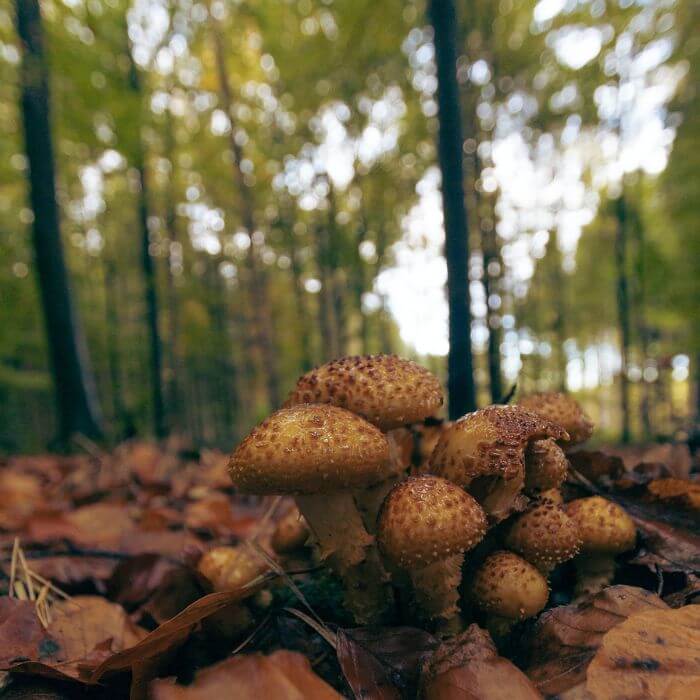
Another common look-alike of the honey mushroom is golden scalycap mushroom, scientific name- Pholiota aurivella. This species closely resembles the edible honey mushroom and often grows in similar habitats.
However, unlike its edible counterpart, the golden scalycap is not recommended for consumption. The cap of this mushroom ranges from yellowish-brown to reddish-brown and can reach up to 3.9 inches in diameter. Note the dark scales on the cap’s surface.
Its gills are initially whitish but turn rusty brown as it matures. This pholiota mushroom typically grows on decaying wood, such as tree stumps or logs, and can be found in both coniferous and deciduous forests.
It has a preference for humid environments and is commonly spotted during late summer and fall seasons. This species, like many other mushrooms that resemble the honey mushroom, can be easily mistaken for the safe-to-eat variety by inexperienced foragers.
Therefore, it is crucial to exercise caution when identifying wild mushrooms and consult an expert if unsure about their edibility.
Honey Mushroom Varieties
Desarmillaria caespitosa
Desarmillaria caespitosa, also known as the cluster mushroom or honey fungus, is a fascinating organism that has garnered attention for its unique qualities.
Found in forests all over North America, this species grows in clusters and forms large underground networks called mycelium. It is renowned for its ability to decompose organic matter, particularly wood.
One interesting aspect of Desarmillaria caespitosa is its parasitic nature. This fungus not only feeds on dead or decaying organic matter but can also infect living trees and plants.
It attaches itself to the roots of these living organisms and releases enzymes that break down their tissues for consumption. As a result, it can cause serious damage to forests and agricultural crops if left unchecked.
Another intriguing feature of Desarmillaria caespitosa is its resilience and adaptability. This mushroom has developed numerous mechanisms to survive in various environmental conditions.
For instance, it can remain dormant during periods of unfavorable conditions such as drought or extreme cold temperatures and resume growth when conditions improve. Moreover, this adaptive ability allows it to colonize different types of substrates ranging from hardwoods to conifers.
Armillaria gallica
One unique characteristic of Armillaria gallica is its parasitic nature. While it can grow as a saprophyte on dead or decaying wood, this cunning fungus is also known for infecting living trees and gradually killing them over time.
It does so by attaching itself to the roots of host plants and invading their tissues with enzymes that break down cellulose—a complex carbohydrate found in plant cell walls—enabling the fungus to access nutrients for growth. This parasitic behavior has earned Armillaria gallica a notorious reputation among foresters and arborists worldwide.
Despite its destructive tendencies, Armillaria gallica may actually play an important role in forest ecosystems. As it decomposes dying trees, it releases valuable nutrients back into the soil that can then be absorbed by other plants, promoting overall biodiversity.
Armillaria mellea
The first step in identifying Armillaria mellea is to closely examine its fruiting bodies or mushrooms. These mushrooms have a distinct honey-colored cap with darker scales and a ring around the stem
The gills underneath the cap are white initially but turn yellowish-brown as they age. Another characteristic feature of this fungus is the presence of rhizomorphs, which are black root-like structures that extend from infected trees into the surrounding soil.
source:
Hi There,
My name is Jenny. I’m the Chief Editor at Try Green Recipes and besides making yummy and healthy foods for my kids, grandkids, and friends. I’m new to the blogging world but I believe what I have to share is unique and will bring joy to your home. If you are adventurous and want try something tasty, let’s get started.

